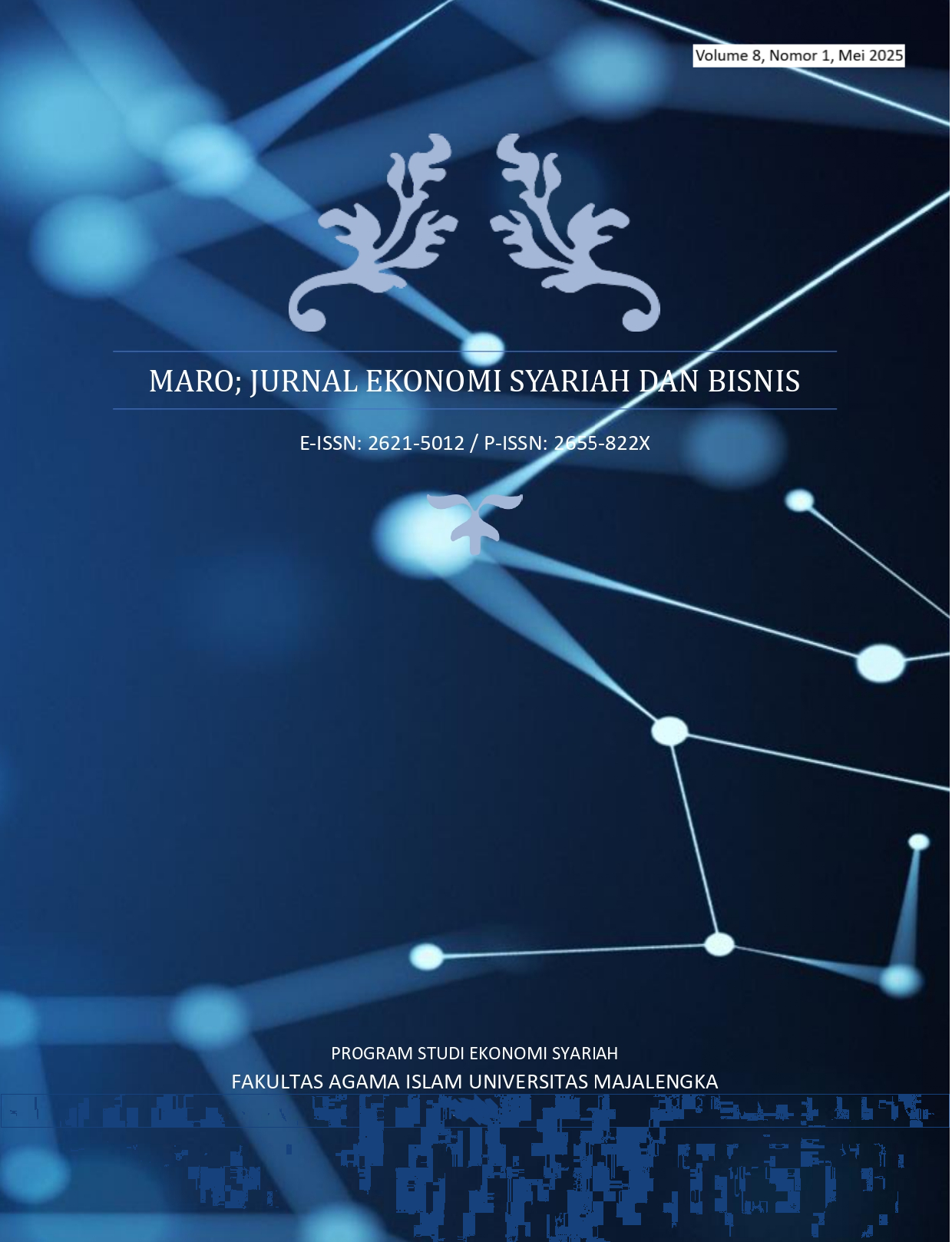Optimalisasi Peran Platform Digital Dalam Kewajiban Membayar Zakat, Infaq Dan Sedekah Di Baznas Kabupaten Tasikmalaya
DOI:
https://doi.org/10.31949/maro.v8i1.12163Abstract
Zakat, infaq and alms are considered forms of worship that not only show vertical obedience to Allah SWT, but also have a horizontal dimension in social and humanitarian relations. Even so, the realization of collecting zakat, infaq and alms funds is still far from its potential in West Java. Therefore, the Tasikmalaya Regency National Zakat Agency continues to strive to overcome this problem. This study aims to analyse how the optimisation of the Digital Platform carried out by BAZNAS Tasikmalaya Regency in the payment of zakat, infaq and sadaqah from muzakki. This research also analyses how public interest, transparency of management of the Amil Zakat Agency and the use of digital platforms, and their relationship to the obligation to pay zakat, infaq and sadaqah at BAZNAS Tasikmalaya Regency. This research uses descriptive verification method with quantitative approach. Data were analysed using validity and reliability analysis, classical assumptions, and multiple linear regression analysis. Data analysis was carried out with the help of the statistical application SPSS for Windows version 26. The data used is primary data obtained through an online survey by distributing questionnaires to respondents. It is concluded that there is a positive and significant influence between Public Interest on the Obligation of Zakat, Infaq and Sadaqah with a tcount> ttable value (9.404> 1.979) with a significance value of 0.000 smaller than 0.05. Transparency of Management of Amil Zakat Institutions on the Obligation of Zakat, Infaq and Sadaqah with a tcount> ttable value (9.253> 1.979) with a significance value of 0.000 smaller than 0.05. Digital Platform on the Obligation of Zakat, Infaq and Sadaqah with a tcount> ttable value (11.312> 1.979) with a significance value of 0.000 smaller than 0.05.
Keywords:
Digital Platform, BAZNAS Tasikmalaya Regency, OptimalisasiDownloads
References
[1] S. Nurhasanah and Suryani, “Maksimalisasi Potensi Zakat Melalui Peningkatan Kesadaran Masyarakat,” JEBI J. Ekon. dan Bisnis Islam, vol. 3, no. 2, pp. 185–194, 2018.
[2] Y. N. Anggraini and R. Indrarini, “Analisis Pengaruh Literasi Zakat dan Kepercayaan terhadap Minat Membayar Zakat Melalui Zakat Digital pada Masyarakat di Kabupaten Sidoarjo,” J. Ekon. dan Bisnis Islam, vol. 5, no. 1, pp. 54–66, 2022, doi: 10.26740/jekobi.v5n1.p54-66.
[3] Charities Air Foundation, “World Giving Index,” 2018.
[4] Legatum Institute, “Legatum Prosperity Index,” 2019.
[5] BAZNAS, “Outlook Zakat Indonesia 2023,” Jakarta, 2023.
[6] BAZNAS, “Pembinaan Unit Pengumpul Zakat (UPZ) Sekolah dan Madrasah se-Kota Tasikmalaya 2023,” Baznas Kota Tasik, 2023. https://baznaskotatasik.com/berita/detail/pembinaan-unit-pengumpul-zakat-upz-sekolah-dan-madrasah-se-kota-tasikmalaya-tahun-2023.
[7] Pusat Kajian Strategis BAZNAS, “Outlook Zakat Indonesia 2022,” Jakarta, 2022.
[8] I. Dwi, “Pengaruh Literasi Terhadap Kepercayaan Muzaki Pada Lembaga Pengelola Zakat Dengan Akuntabilitas Dan Transparansi Sebagai Variabel Inte,” Econ. Educ. Anal. J., vol. 2, no. 1, pp. 18–23, 2019.
[9] Irfan Syauqi Beik and Izzatul Mabniyyah Alhasanah, “Analisis Faktor-Faktor Yang Mempengaruhitingkat Partisipasi Dan Pemilihan Tempat Berzakat Dan Berinfak,” J. Ekon. Keuang. Islam, vol. 2, no. No.1, pp. 64–75, 2012.
[10] Asminar, “Pengaruh Pemahaman, Transparansi dan Keputusan Membayar Zakat Pada Kota Binjai,” At-Tawassuth, vol. III, no. 3, pp. 260–281, 2017.
[11] M. Ilyas Junjunan, “Pengaruh Transparansi, Akuntabilitas, dan IGCG terhadap Tingkat Kepercayaan Muzakki di Lembaga Amil Zakat Dompet Amanah Umat,” Akunt. J. Akunt. Integr., vol. 6, no. 2, pp. 112–125, 2020, doi: 10.29080/jai.v6i2.289.
[12] D. Friantoro and K. Zaki, “Do We Need Financial Technology for Collecting Zakat?,” Int. Conf. Zakat, 2019, doi: 10.37706/iconz.2018.133.
[13] M. Rizaludin As, “Peran Digitalisasi Zakat dalam Peningkatan Fundraising dan Jumlah Muzakki di Indonesia,” Tadabbur J. Integr. Keilmuan, vol. 1, no. 1, 2022, doi: 10.15408/tadabbur.v1i1.27866.
[14] J. Noor, Metodologi Penelitian Skripsi, Tesis, Disertasi Dan Karya Ilmiah. Jakarta: Kencana Prenada Media Group, 2010.
[15] Hardani et al., Metode Penelitian Kualitatif & Kuantitatif. Yogyakarta: CV Pustaka Ilmu Group Yogyakarta, 2020.
[16] Sugiyono, Statistika Untuk Penelitian. Bandung: Alfabeta, 2016.
[17] Sugiyono, Metode Penelitian Kuantitatif Kualitatif Dan R&D. Bandung: Alfabeta, 2013.
[18] I. Ghozali, Aplikasi Analisis Multivariate dengan Program IBM SPSS 23, 8th ed. Semarang: Badan Penerbit Universitas Diponegoro, 2016.
[19] B. Prasetyo and L. M. Jannah, Metode Penelitian Kuantitatif. Jakarta: PT Raja Grafindo Persada, 2006.
[20] S. Siyoto and M. A. Sodik, DASAR METODOLOGI PENELITIAN, 1st ed. Yogyakarta: Literasi Media Publishing, 2015.
















